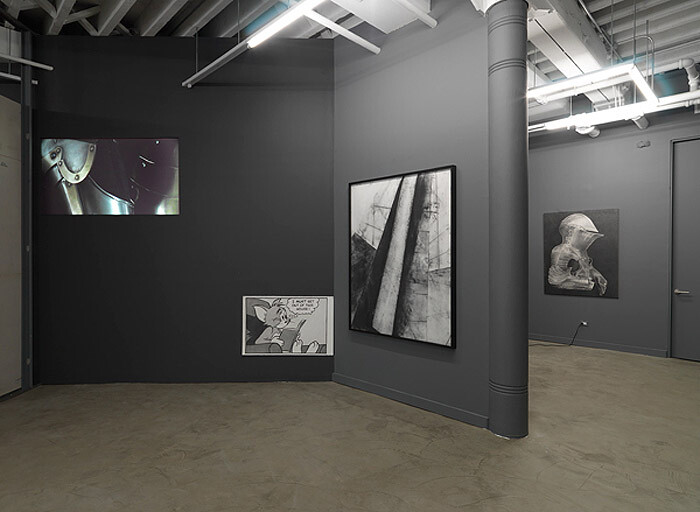“I must get out of this house,” betrays the thought bubble floating near Tom’s bewildered expression as he sits in an overstuffed chair with an open book in his hands. Tom, the feline-half of the notorious duo Tom & Jerry, sits alone without his little tormentor in Karl Haendel’s Tom & Jerry #3 (2010), a hand-drawn graphite appropriation of a comic panel that muses on Tom’s self-awareness. The book the cat holds in this frame is a generic “everybook,” and its ability not to hold Tom’s attention undercuts the very notion of storytelling to which he exclusively belongs. In Haendel’s decontextualized comic, re-rendering Tom in a moment of contemplation emancipates him from the cultural construction of storytelling.
Haendel is an ambitious inheritor of the promiscuous appropriation strategies practiced by the Picture Generation artists of the 80s. His interest in redrawing and re-presenting images however is notably less skeptical and less ironic than that of the early work produced by Robert Longo, Troy Brauntuch, and Barbara Kruger. Yet Haendel too is compelled to detach and recontextualize the images, objects, and signs that orbit his field of interest, resulting in work dedicated to similitude and semiotics. In his project at the Tony Wight Gallery, Haendel hones in on three seemingly disparate motifs: Tom & Jerry comic panels, medieval armor, and panes of broken glass.
Choreographed into cerebral clusters on gray gallery walls, these tableaux are juxtaposed by the inclusion of two slide projectors clicking off continuous black-and-white slide projections and one large back-screen video projection. Haendel also refigured the volume of the gallery’s two modest-sized exhibition spaces by erecting freestanding walls set at diagonals to the pre-existing perpendicular rooms. By exposing the temporary wall’s light-gauge metal stud framing and displaying bagged garbage, Diet Dr. Pepper cans, water bottles, empty paint cans, unused lengths of corner beading, along with other refuse left over from the installation process on the floor along the backside of these walls, Haendel negotiates a range of production value among the elements coalescing in My Invisible Friend.
In addition to a selection of enlarged copies of Tom & Jerry comic panels, the armor of the medieval knight, with its reflective material and bizarre anatomical approximations compel its graphite rendering. The knight’s chivalrous social status is also an exceptional cultural study whose credo—stated in the press release as “Protect the weak, defenseless, helpless, and fight for the general welfare of all”—is without equivalent today. Haendel also made a silent video that slowly scans a suit of armor at a close range. The monochromatic nature of the metal makes reference to Haendel’s drawings but fragments of reflective color and a moving play of light recorded by the camera as it peruses the relic open up a naturalistic space that is absent from the works on paper.
Haendel’s drawings of broken glass are rendered not via the act of copying but rather by spraying through a shattered piece of glass—in this way, he achieves an uncanny record, an index of the altered material. The metaphors associated with shattered glass are vast, but here Haendel makes specific reference to the Jewish wedding tradition, suggesting that “the broken glass is irrevocably changed; likewise, the couple is forever changed by marriage and must accept this and take on a new form.”
These intemperate abstract images dispensed throughout the space, especially in juxtaposition with the drawings of the metal armor created a powerful visual and symbolic contradiction. As Jerry is Tom’s foil, the shattered glass is the altruistic iron-clad knight’s metaphorical rival. Haendel’s appropriations and indexes are not simply a critical game of deconstruction. Nor is his commitment to copying a relative or nihilistic practice. The post-structural strategies he employs ironically add up to polemical face-offs that shore up the binary oppositions that prevent cultural drift. Haendel is a structuralist in post-structural clothes.





